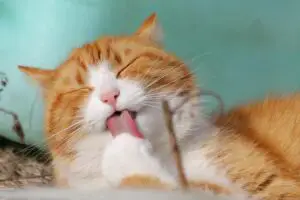
Can our cats taste the same as we humans do? This is whether the cat feels bitter and whether sugar-free foods are to his liking.
Do we really know all about the cat’s senses? Can we say with certainty that the feline has developed taste just like all the other abilities of him? We could discover very interesting things that we completely ignored. So here is if the cat feels bitter and how he reacts to sugar-free foods, and how different is the sense of taste of cats compared to that of us humans.
The sense of taste in cats: how it works and how different it is from ours
If the human senses of smell and sight cannot even be compared with those of our cat, on the front of taste we can ‘play it’. In fact, apparently, our sense of taste is even higher than the feline one!
At the level of taste buds, the human ones reach a peak of 9000, while those of the cat usually do not exceed 473. They, albeit in different numbers, have a fundamental function for the life of all human beings, since they allow to distinguish a taste from other.
Only by tasting the tastes a cat, as well as a human, will be able to understand which foods he likes and which ones his palate just doesn’t like. In fact, the taste buds detect the taste and send the detected messages to the brain, which will process them.
Not only for cats, which are purely carnivores, but also for herbivores in particular, the sense of taste is essential to distinguish harmful and toxic plants and herbs from good and non-harmful ones.
The cat feels bitter but not all tastes: here’s what it doesn’t ‘feel’
It may seem strange that an animal with overdeveloped senses like the feline can be ‘inferior’ to us in terms of taste. It is not just about the number of taste buds, but also about being more or less sensitive to one taste rather than another.
In particular, the palate of cats does not detect the sweet taste: in fact they are able to perceive the salty, the bitter, the acid and the so-called ‘umami’ (in Japanese: tasty) but not the sweet. This ‘deficiency’ was created during the evolutionary process of the cat: the cat needed to distinguish a bitter food and therefore presumably bad and spoiled from the sweet one.
We also consider that the cat’s body has no need to assimilate carbohydrates and sugars, so it hasn’t even made a lot of effort to recognize them. But if we see our domestic feline wandering suspiciously around a sweet, should we think of an exception? Probably not, because the cat can be attracted only by the fat of that food and not by the sugars.
Finally, cats do not have the digestive enzyme of sugars (glucokinase), unlike dogs and humans, and then they receive all the sweet components they need from plants.
The cat feels the bitter: how it does it in ‘scientific terms’

Scientists have studied the two ultimate feline taste receptors: Tas2r38 and Tas2r43.
Based on the results carried out on cats, it seems that these receptors are much more sensitive to bitterness than humans: in practice they perceive it much more and more markedly.
Perhaps this is also why our domestic cats seem so ‘picky’ about food, precisely because they detect different tastes than those detected by our palate. And then we also consider other factors that are fundamental for the choice of a food by the feline: the size, the shape and even the temperature (preferably at room temperature or around 30 °).
How the cat eats: the Jaconbson organ
Do you know what Jacobson’s organ is in the cat? Let’s find out together, we have already explained the functions of this ‘further organ’ that dogs and cats possess and that connects the nose to the mouth.
Its function is to smell foods and avoid those that have an unpleasant smell but also for pheromones. It is no coincidence that cats are said to eat with their noses, which is not entirely wrong, it seems.






